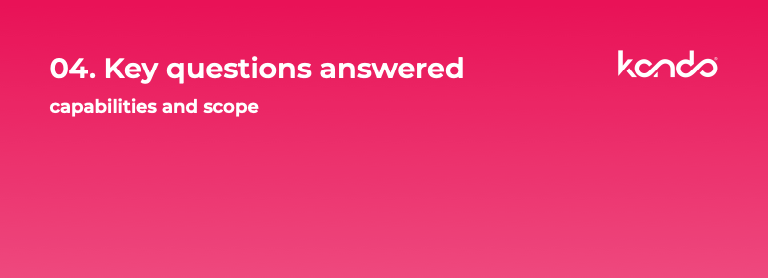Admin
December 23, 2021
FAQ Kando Pulse
Download Content

On this page, you can find Frequent Questions & Answers (FAQ) regarding the Kando Pulse Platform.
If you have more in-depth questions, feel free to connect with Anne-li Maron, Business Development
FAQ discussing the capabilities and scope of Kando Pulse platform.
Question 1
Can the system use machine learning to develop long-term condition trends and identify potential pollution events?
Yes. Kando’s web-based analytics engine determines baseline quality characteristics at each deployment location automatically. The goal is to equip the system with a model of ‘normal’ network conditions, enabling it to identify changes that indicate possible pollution events. The wastewater quality baseline is generated by machine learning processes on two levels:
- Learning the average normal level of each measured parameter (EC, PH, ORP, temp).
- Generating a correlation curve against known wastewater characteristics, determined by comparative analysis of live condition reporting against laboratory sample analysis.
By tracing condition data over extended periods, Pulse can automatically generate long-term trend reports, supporting optimal capital investment, maintenance, and operative planning.
04. Key questions
Question 2
Can samples be taken only in response to a disturbance of these basic parameters to allow the sample to be collected precisely when the discharge event occurs?
Yes. Kando’s solution includes dedicated software and hardware components, engineered to support precise, ‘event-triggered’ sample collection (in line with ISO 5667-10:2020):
- Each element of our hardware (sensors, battery, IoT enabled controller, and autosampler) was specially designed or integrated to operate remotely within user networks. All components were chosen or designed to sustain the harsh environment of collection systems and to allow easy operation and maintenance. The solution provides maximum flexibility and doesn’t require infrastructure changes.
- Our algorithm is designed to identify changes in wastewater quality at specific locations. When network conditions deviate from automatically established ‘norms’, the system triggers an automated sampler to take a grab sample of the event, alerting users when it is ready for collection.
Question 3
Can water quality parameters be sent via telemetry to an online system with pattern recognition to identify potential upstream sources of the discharge based on the GIS database of all industrial users?
Yes. The process’ goal is to support the key capabilities of: A) detecting pollution events; B) pinpointing the sources of events, and C) providing network insights. A key capability of this system is the capacity to trace pollution evenets back upstream, identifying their likely point of origin. Field IoT units transmit data directly from client networks to Kando’s web- based analytics engine.
Upstream source detection is made possible as each data gathering unit’s relative position within the network is known. By correlating data from each unit and combining findings with user GIS data and network information, users can determine:
- The parent point (if any) – indicated by the nearest unit downstream of the contamination entering the system
- The time (in minutes) to the parent point, a pollution event’s progress through the network given flow velocity, and its estimated time of arrival at the wastewater treatment plant.
Pulse indicates an estimated source point upstream (suspect) For every pollution event detected.
Fig.5, Identifying potential upstream sources
Question 4
Can the online database alert downstream receivers (wastewater treatment plants) when the parameters exceeds certain set points?
Yes. Kando’s ability to create downstream early warning alerts involves the following:
- A hierarchical network of IoT data gathering units with known relative positioning withing a network. This is done using Kando’s strategic deployment methodology and sewer main data, provided by the client through GIS records.
- The ability to identify events in real time, using automated remote condition data reporting and analytics, and trace them from source to the WWTP using flow behavioral data throughout the collection system, GIS and simplified hydraulic models
- A comprehensive data handling platform that generates and sends automated event alerts when an event is detected.
Kando’s system sends registered operators mobile and/or email alerts (dependent upon user preferences) when an event is detected, and provides detailed event mapping and profiling via the online Pulse data platform and online dashboard.
Register to see the full content
and download the article
Your wastewater contains the data.
We just need to extract it so that you can optimize your operations.
Contact us and a member of our team will get back to you as soon as possible.

